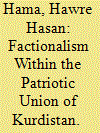|
|
|
Sort Order |
|
|
|
Items / Page
|
|
|
|
|
|
|
| Srl | Item |
| 1 |
ID:
168245


|
|
|
|
|
| Summary/Abstract |
Institutional conflicts within the Patriotic Union of Kurdistan (PUK) have existed ever since the party’s founding in 1975 as a result of a merger of three different factions. The conflicts were successfully managed in a way that did not hurt the party’s overall functioning until the Gorran movement, led by Nawshirwan Mustafa, split off in 2009. However, it was the withdrawal of party leader Jalal Talabani from political and public life due to a stroke suffered in 2012 that most damaged the party’s ability to function, and widened factional cracks within the organization. The absence of Talabani led to the emergence of intense competition between various groups within the PUK for influence and positions. Consequently, PUK policies on a number of important issues in Iraqi Kurdistan have been indecisive and weak since approximately 2013. This research will discuss the PUK’s inconsistent policies and their negative implications for the Kurdistan Region. Furthermore, it will argue that the PUK’s internal conflicts emboldened its rival, the Kurdistan Democratic Party, between the years 2014 and 2018.
|
|
|
|
|
|
|
|
|
|
|
|
|
|
|
|
| 2 |
ID:
166770


|
|
|
|
|
| Summary/Abstract |
In the early morning of 3 August 2014, Islamic State of Iraq and Syria (ISIS) attacked the Sinjar district in the vicinity of Mosul. The area was largely under the control of Kurdish forces at the time, especially those associated with the Kurdistan Democratic Party (KDP). Those forces could not defend the district and ISIS was able to take control of the area. Consequently, a considerable number of Yazidi people were killed or displaced, while female Yazidis were raped and kidnapped. This study, based on framing theory, attempts to explain how two major Kurdish media organizations, Rudaw, which is loyal to KDP, and the Kurdish News Network (KNN), which is loyal to the Gorran (Change) Movement, each covered the event in their news reports. By performing a content analysis of 222 news stories covering the event, the key finding of the research is that, in instances of assigning responsibility for the fall of Sinjar, political considerations are the determining factor in how the narrative was framed. Taken as part of a growing literature on media in Kurdistan, the research outlined in this article supports the conclusion that the framing of media coverage in the Kurdistan Region is subject to strong political bias and media organizations support the political narratives advanced by their political patrons, as it is the case in many other Middle Eastern countries.
|
|
|
|
|
|
|
|
|
|
|
|
|
|
|
|
|
|
|
|
|